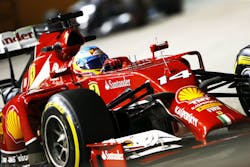With 23 corners, Singapore is the track with the most twists and turns of the year, and the same is likely to be true when it comes to the story of the race. Although the grand prix is held at night, ambient temperatures and in particular humidity is extremely high, as was the case during free practice this evening. Along with little run-off space, this ensures that Singapore is one of the most unpredictable races of the year.
Three pit stops are most likely, depending also on safety cars. The P Zero Red supersoft and P Zero Yellow soft compounds have been nominated for the weekend, with a difference of around 2.5 seconds per lap in pace so far. This gap is likely to come down slightly with pace management and as the circuit rubbers in and cleans up: there was debris from a full program of support events on the track today, as well as a brief rain shower in the morning before the cars were running.
The lap time difference means that the supersoft will be the automatic choice for qualifying, and this will affect the entire race strategy. In the past, the Singapore Grand Prix has often gone to the full two hours of action – because of the relatively low average speeds and frequent interruptions. As a result of this, strategy will become absolutely crucial, with teams trying to gain a tactical advantage through the timing of their pit stops. The fastest time of the day was set by Lewis Hamilton for Mercedes in FP2 on the supersoft tire, with a benchmark of 1m47.490s. However, Ferrari’s Fernando Alonso – fastest in FP1 – was just a tenth of a second behind on the same tire.
Paul Hembery: “The time difference between the two compounds was perhaps slightly bigger than we expected, but the nature of the track and the conditions are such that this is unlikely to alter considerably as the weekend goes on. With the high incidence of safety cars and the speed advantage of the supersoft, strategy will be an important consideration right from the very start of qualifying. Strategies will obviously have to be flexible, and we would expect to see three stops. As expected thermal degradation will be the biggest challenge here, with the degradation levels of the soft and the supersoft tire actually not so different. We need to look at the data from tomorrow as well in order to have a more complete idea of the optimal race strategy, but tire management will clearly play a significant role.”
Latest in Retail
Latest in Retail



